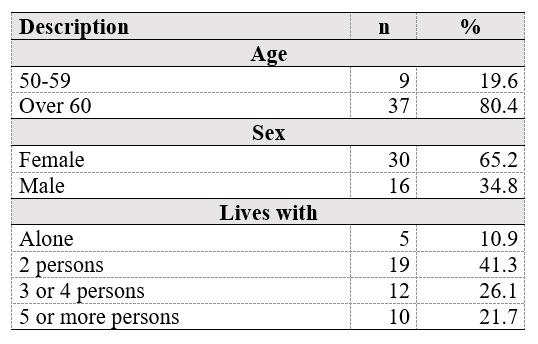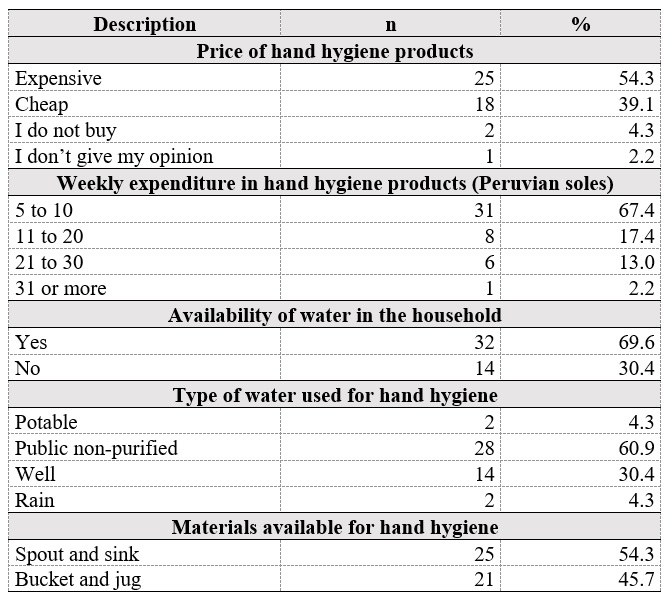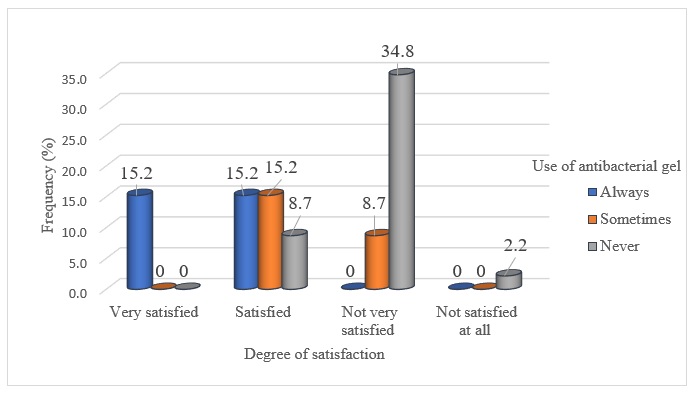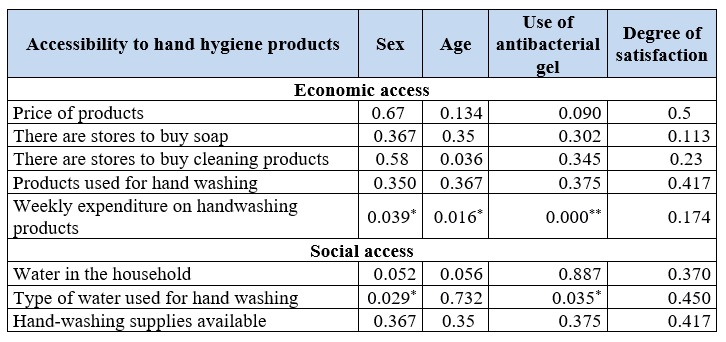Introduction
By August 1, 2021, there were 198,282,165 cases of COVID-19 in the world, and more than 4,000,000 million people had died. In addition, the rapid spread of the virus caused the health systems of Chile, Peru, Colombia, Panama, and Bolivia to be overcrowded. Peru was the American country with more than one million inhabitants with the highest mortality rate: 196,353 deaths and more than two million confirmed infections (1).
The Amazonas region, located in northeastern Peru, registered 29,245 positive cases, distributed among its 7 provinces: Bagua, with 9,756 cases; Bongará, with 967 cases; Chachapoyas, with 4,918 cases; Condorcanqui, with 6,105 cases; Luya, with 1,418 cases; Rodríguez de Mendoza, with 663 cases, and Utcubamba, with 5,418 cases, of which 350 women and 281 men in Chachapoyas were over 60 years of age (2).
This pandemic has aggravated the hardships of the poorest and most vulnerable people, as well as inequalities in access to water, sanitation, medical services and housing. This has generated high infection and mortality rates in rural areas, marginal urban, and indigenous populations (3).
Data on handwashing culture reveal that at least 50% of people are not in the habit of washing their hands automatically after using the toilet. In Thailand and Kenya, 48% of people do not have this habit. In Italy this percentage is also high, at 43 % (4). A study conducted in the United States showed that people with lower income and education had lower rates of handwashing and surface disinfection (5). In Brazil, 27%; in Ecuador, 24%; in Argentina, 20%; and in Peru, 18% do not wash their hands (4). Meanwhile, in Lima, 77.2% of caregivers of older adults have not received training in handwashing (6), and even fewer wash their hands correctly.
In addition, adults, especially with coexistence of one or more diseases, are fragile and more susceptible to infection (7). There are marginal urban areas whose human settlements lack basic sanitation services, such as drinking water supply, adequate sewage disposal and solid waste disposal.
The Human Settlement 16 de Octubre, in Chachapoyas (Peru), is no exception, as it does not have basic services. It is currently supplied by two surface sources that are in very poor condition. Water is consumed without prior treatment, and there are cesspools for excreta disposal. In addition, the presence of total coliforms, helminth eggs, and larvae and Escherichia coli, among others, has been evidenced in the water (8), a situation that complicated the hand washing technique.
In addition, the adults and older adults living in the area have low purchasing power, which made it difficult for them to purchase cleaning products. Because of this, it was necessary to provide them with antibacterial gel prepared in the laboratory of the public university of this city. In the total quarantine period, during the first ninety days of the year 2020, the shortage of gel in stores, drugstores, and pharmacies worsened, its price rose three times its normal value, and it became very difficult to acquire it. This predisposed the population of that province to increase the morbidity and mortality rate due to COVID-19, without being able to stop it.
In this regard, research such as that of Ayenigbara et al. (9) revealed that thorough hand washing with antiseptic soap and running water, the use of alcohol-based hand sanitizer, frequent cleaning of surfaces, strict adherence to social distancing, regular respiratory physiology and the use of protectors are the best allies to prevent contagion. Hence, surface disinfection, hand washing with soap and water, and space ventilation have been the most effective measures to overcome the spread of SARS-CoV-2. The general disinfectant action weakens the virus by depleting the lipid membrane with a disinfectant and removing it from the surface. Thus, individual hand washing is strongly recommended (10).
On the other hand, the antimicrobial efficacy of gelling alcohol on hands is due to its ability to alter microbial proteins. At concentrations of 60-80%, its effectiveness is greater. The fact that it contains only one emollient prevents the skin from drying out, and it is not necessary to use a paper towel to dry the hands (11).
In this context, the purpose of the research was to determine the relationship between accessibility to hand hygiene products, the use of antibacterial gel, and the degree of satisfaction of adults and older adults in the Human Settlement 16 de Octubre, in the province of Chachapoyas.
Methods
This study had a quantitative approach and a relational, prospective, cross-sectional, and analytical design. (12). The sample consisted of 46 adults, 9 of whom were between 50 and 59 years old; 37 were over 60 years old, and were lucid, oriented in time, space and person, voluntarily agreed to be part of the study and received on two occasions (June and December 2020) a 500-milliliter bottle of antibacterial gel prepared in the laboratories of Agroindustrial Engineering at the Universidad Nacional Toribio Rodríguez de Mendoza de Amazonas. Non-probability purposive sampling was used.
The questionnaire used had four parts: 1) economic access, which focused on the economic availability of adults to buy the necessary supplies for hand washing; 2) social access, related to accessibility to water for hand washing; 3) use of antibacterial gel, which focuses on the frequency of gel use; and 4) degree of satisfaction, which measures how satisfied adults are with the use of antibacterial gel. All questions were closed-ended, multiple choice questions.
Regarding the variables studied, validation was determined by the judgment of experts (five professionals), who, using a dichotomous scale, issued their judgment. Then, by binomial distribution, a calculated value (CV) of 8.88 > 1.64 than the theoretical value (TV) was obtained, which showed that the instrument was adequate. Reliability was established by Cronbach’s alpha, for the dimensions with Likert scale, and for the closed and dichotomous dimensions, Kuder-Richardson 20, which obtained a value of 0.75 (strong reliability) for both cases. Likewise, a nominal scale was used for the final values of the Accessibility variable, and a dichotomous scale was used for the Use of antibacterial gel variable (Yes = 1; No = 0). Meanwhile, an ordinal scale was used for the degree of satisfaction, from not at all satisfied (1 point) to very satisfied (4 points).
The research was approved by Resolution 0024-2020-UNTRM/VRAC, by the Academic Vice-Rectorate of the Universidad Nacional Toribio Rodríguez de Mendoza de Amazonas, and ethical principles such as beneficence, non-maleficence, human dignity, and justice were applied at all times (13).
The final information was processed in SPSS software, version 25, and using Excel® 2019 spreadsheets. The nonparametric chi-square test was used, with a significance level of p = 0.05. The results were presented in double-entry tables and bar graphs.
Results
A study was carried out with 46 adults and older adults. Of these, 80.4% were older adults, 65.2% were female, and 41.3% lived with two people in their household (Table 1).
Regarding the accessibility to hand hygiene products, 54.3 % consider these products to be expensive; 67.4 % spend between 5 and 10 soles per week; 69.6% do have access to water in their homes; 60.9% say they use non-potable public water, and 54.3% say they have a spout and sink for hand hygiene (Table 2).
Regarding the relationship between the use of antibacterial gel and satisfaction, it is evident that 34.8% never used antibacterial gel, and are not very satisfied. However, 15.2% always used it and were very satisfied. When subjected to the chi-square statistical test, a significant relationship (p = 0.000) was found between the use of antibacterial gel and the degree of satisfaction of older adults (Figure 1).
Regarding the relationship between accessibility, use of antibacterial gel, and degree of satisfaction, there was a significant relationship between weekly expenditure on handwashing products, sex (p = 0.039), and age (p = 0.016). It was highly significant with the use of antibacterial gel (p = 0.000). A significant relationship was also found between the type of water used for hand washing and the use of antibacterial gel (p = 0.035) (Table 3).
Discussion
From the research, it was found that 80.4% were older adults, mostly female, and 41.3% lived with two people in their household. Similar results were obtained in the study carried out in Guadalajara (Mexico), in which there were more women (65.38%), and those living with one or more people (71.53%) with previous cardiovascular diseases predominated (14).
More than half of adults and older adults consider that hand hygiene products are expensive, since they spend between 5 and 10 soles per week. Because of this, they may not buy these products, and wash their hands only with water. In the case of those who do not have a water supply in their households, they may not even wash their hands, so they are at risk of not eliminating the COVID-19 virus, which is essential to avoid infection. Review studies have pointed out that the practice of hand washing at home is related to a reduction in COVID-19 infections (4), so the need to establish causality between them is widely affirmed.
Very little research was found related to adult and older adult hand hygiene. Studies on the adherence of health personnel to hand washing predominate. More than half of them have knowledge, but little information on the use of alcohol gel, and state that sometimes they do not do it because they do not have time, due to work overload (15). Maintaining proper hand hygiene substantially protects against COVID-19. However, it becomes complicated if the person does not have the supplies; this further harms the health of adults and older adults whose immune systems are depressed, impaired and at high risk of infection.
Likewise, the older adults in the study had a water supply in their household; however, 60.4% of the water is public and not potable, and 30.4% comes from wells. When compared to a survey conducted in Chimbote (Peru), 76 (100 %) of the older adults had water available at home (16). Despite the right to this liquid and to sanitation in Latin America and the Caribbean (17), this study shows that human settlements such as 16 de Octubre in Chachapoyas do not have potable water for human consumption, let alone for hand hygiene. This puts people’s lives at risk, especially those of the most vulnerable, such as the older adults, even more so at this times of pandemic. There is a need to join efforts to promote health equity among partnerships with community organizations, community members, and other key stakeholders, to amplify messages about effective COVID-19 prevention.
In 2015, clean water and sanitation were considered a priority within the seventeen Sustainable Development Goals, and a goal to achieve by 2030. However, according to the United Nations (18), there is a deficit in terms of quality of life and minimum health conditions, which leads to an environment of desolation and human losses, with a pandemic that has no end in sight. In view of this, multisectoral commitments and the link with academia are still minimal, so the researchers propose to implement university social responsibility through the production of alcohol gel to improve the quality of life of the study participants.
Alcohol-based hand sanitizer made with the formula recommended by the World Health Organization is more effective in killing germs than hand washing with soap (19). The gel produced from the ethanolic extract of chiba senecio has an antibacterial effect in vitro (20). Chacaltana-Alejos et al. (21) refer that green gels are antibacterial gels made from essential oils of eucalyptus, rosemary, and lemon, inputs of ancestral medicine that have become an alternative to strengthen preventive measures against COVID-19.
The degree of relationship between these variables allows inferring that having greater accessibility to hand hygiene products, frequent use of antibacterial gel and a high degree of satisfaction among older adults, implies reactivating processes and channeling activities in vulnerable areas, such as human settlements, particularly 16 de Octubre in Chachapoyas, which is where intervention projects should be channeled in the coming years.
On the other hand, there was a significant relationship between weekly expenditure on handwashing products and age and sex, and the highly significant relationship with the use of gel, as well as a significant relationship between the type of water used for handwashing and the use of antibacterial gel (p = 0.035). It is necessary to implement a continuous education program on the importance and techniques of hand hygiene for workers, and periodically evaluate its effectiveness (22). This leads to planning continuing education strategies with adults and older adults, their families, and community, as well as managing the future installation of potable water in homes.
In this sense, in the current pandemic context, developing countries face a major problem in terms of availability of resources, especially in marginal populations with deficient or non-existent systems for the provision of quality water for adequate hand hygiene (19,20). Because of this, some countries have promoted the domestic production of alcohol-based hand sanitizers with a high level of efficacy (21). In addition, urban-marginal populations are generally migrants from the countryside, people with different hygiene habits and with low probabilities of incorporating the recommendations of the authorities to contain the advance of COVID-19 (23).
The findings allow us to infer that in the study population, the greater the weekly economic expenditure on hand hygiene products, the greater the use of gel, and if the water is public or well water, hand hygiene becomes deficient and, therefore, the use of an antibacterial gel becomes urgent, and it would be better if it is made from essential oils. In this regard, medicinal plants have become an option for making gels in Peruvian communities, and can be inputs for health care, especially in older adults, who know and practice ancestral cures and who would find it easier to adapt to a habit of hygiene with plants with which they have lived.
Finally, hand washing with soap and water should continue to be promoted as a basic prevention measure to combat COVID-19. It is also urgent that there be a link between local and regional governments and companies and academia, whose work is reflected in meeting the needs of the neediest sectors, and translated into the improvement of human and social development indexes.











 text in
text in 







